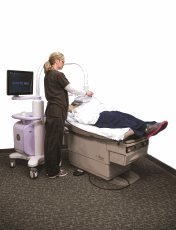Breast Density Awareness Program Launched at LMHS
 Women with dense breast tissue are at four to six times as likely to develop breast cancer than women without dense tissue. Although mammography detects many instances of cancer, the technology does have known limitations. Mammography reveals approximately 85 percent of cancers in patients, but for women with dense breast tissue, that number drops to 65 percent.
Women with dense breast tissue are at four to six times as likely to develop breast cancer than women without dense tissue. Although mammography detects many instances of cancer, the technology does have known limitations. Mammography reveals approximately 85 percent of cancers in patients, but for women with dense breast tissue, that number drops to 65 percent.
Licking Memorial Health Systems (LMHS) has launched a breast density awareness program to inform screening mammography patients of their breast density, promote a patient-centric approach to breast cancer screening and offer supplemental 3D screening Automated Breast Ultrasound (ABUS). The program will help inform women about the cancer risks associated with their own pattern of breast density as well as conform to new legislation established by the State of Ohio.
Legislation now mandates that screening mammography patients demonstrating greater than 50 percent breast density should be informed of their density and the limitation of screening with mammography alone. The law, which became effective in March 2015, requires that a facility send a summary of the mammography report to each patient containing the result.
An additional statement is given to those with dense breast tissue, advising the patient that, although this is a relatively common condition, it is possible there are abnormalities that were hidden by dense tissue during the mammography screening. The purpose of this new process is to promote awareness and discussion between the patient and their healthcare provider.
The information regarding a patient’s breast composition is now added to the reports provided routinely to both the physician and the patient. Depending upon the patient’s individual risk factors, the physician may recommend additional tests.
Breast composition is described in one of four patterns of increasing density:
1. The breasts are almost entirely fatty tissue.
2. The breasts contain scattered areas of fibroglandular density.
3. The breasts are heterogeneously dense, which may obscure small masses.
4. The breasts are extremely dense, which lowers the sensitivity of mammography.
A number of studies have shown a significant improvement in breast cancer detection for dense breast tissue with the use of screening ultrasonography as an adjunct to mammography. Screening ultrasonography can help find cancers in women with heterogeneously or extremely dense tissue when cancers are more likely to be treatable.
“There is a need for patients to be properly informed about their own breast tissue density and the Health Systems is committed to creating awareness about this issue,” said Joseph Fondriest, M.D., LMH Chief of Radiology. “LMHS is now pleased to offer the only FDA-approved breast ultrasound screening technology, ABUS, specifically developed to increase breast cancer detection for women with dense breast tissue with no previous clinical interventions.”
One of three cancers may go unnoticed on a mammography for a patient with dense tissue. The ABUS technology will enhance the ability to detect cancers that are hidden and reduce interval cancers. Combining mammography and ultrasound screenings for patients with dense tissue has been highly successful, identifying up to 97 percent of all breast cancers.
The LMHS breast density awareness program and ABUS technology will help increase patient awareness of risk factors, as well as detect cancers that have formed, so that treatment may begin sooner. For further information about which screenings are recommended for you, consult your primary care physician.
| Posted On : 6/30/2015 10:35:17 AM